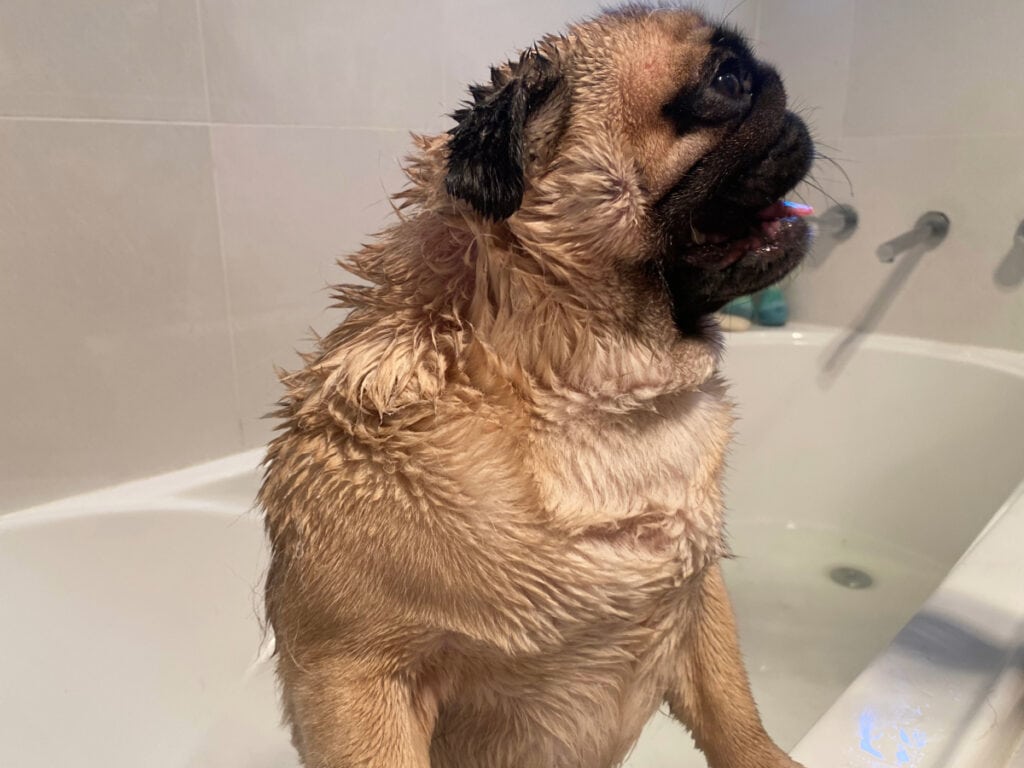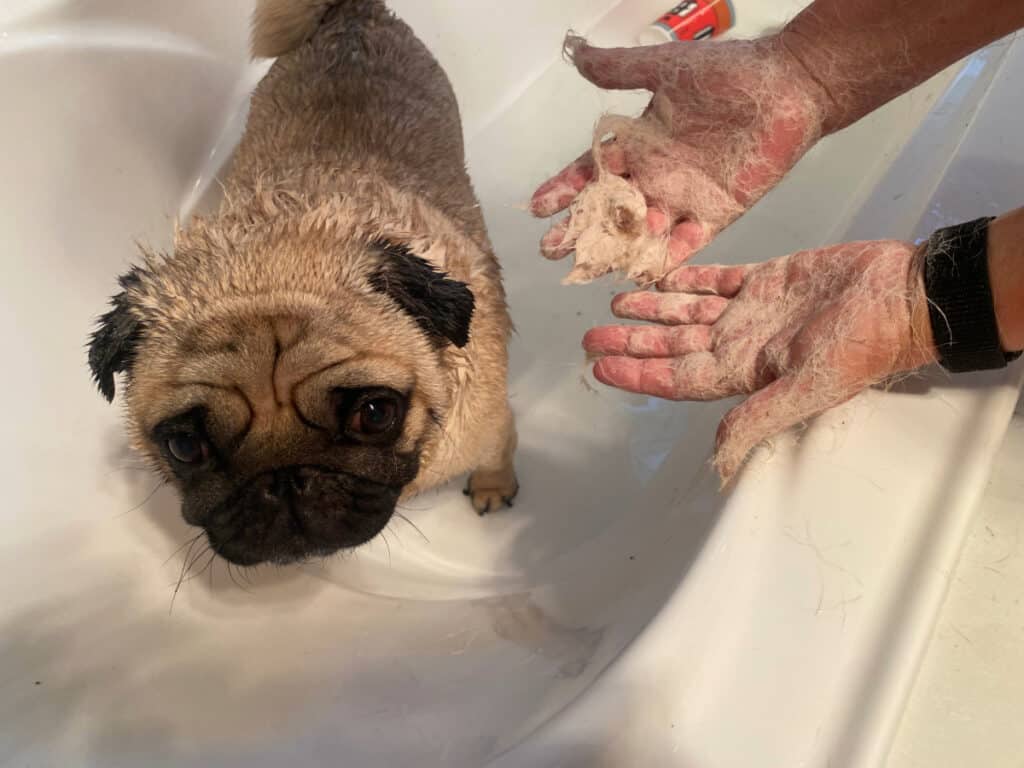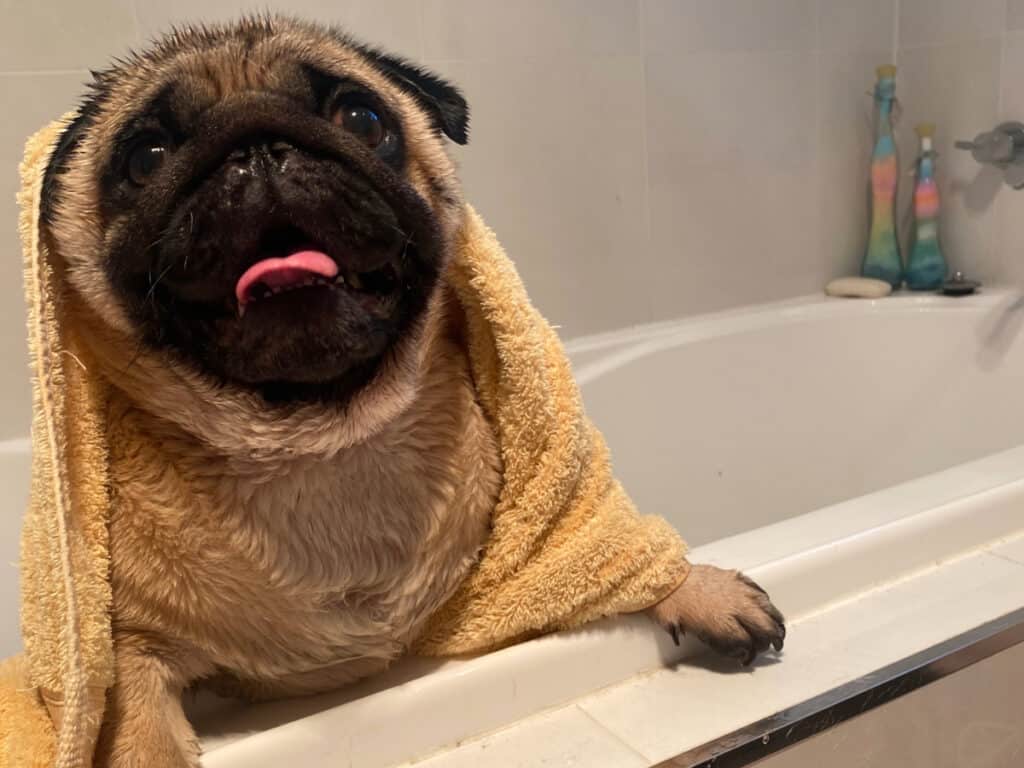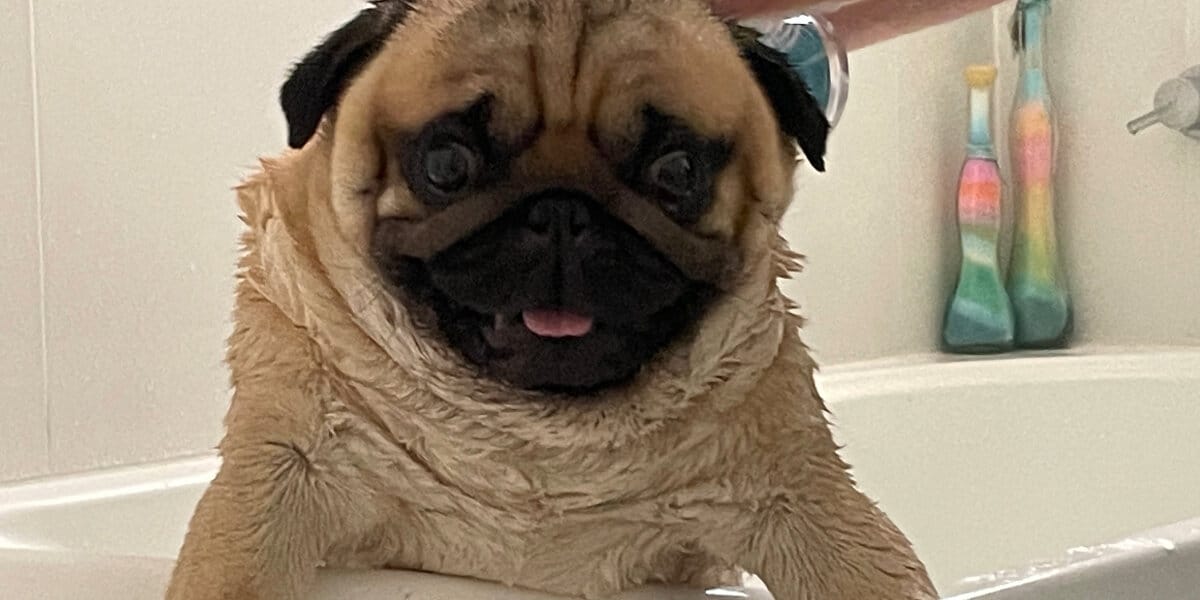Taking care of our pug is always a top priority, especially when it comes to hygiene. Bathing our pugs is an essential part of their grooming routine, but how often should we wash our pugs? If you are a pug owner, you might have wondered how frequently you should bathe your pug. In this blog post, we will discuss the factors that determine the frequency of pug bathing and share some tips on keeping your pug clean and healthy.
Pug baths should be done every 3 weeks to remove body oils that accumulate over time and prevent skin pores from becoming blocked. Bathing may need to occur more often if your Pug becomes particularly dirty or if skin issues arise. Bathing also frees loose hairs, reducing the amount of shedding during brushing.
Tips for bathing your Pug
Bath time can be stressful for both Pugs and their owners, but it doesn’t have to be. Here are some tips to make it a more enjoyable experience for both of you:
1. Use a non-skid mat: Put a non-skid mat at the bottom of the bathtub to prevent your Pug from slipping and sliding during the bath.
2. Use lukewarm water: Pugs can easily get overheated, so make sure the water is not too hot or too cold. Lukewarm water is ideal for their sensitive skin.
3. Use a mild shampoo: Pugs have sensitive skin, so use a mild shampoo that’s formulated for dogs. Avoid using human shampoo or soap, as it can cause irritation and dryness.
4. Dry them thoroughly: Pugs have wrinkles on their face and skin folds on their body that can trap moisture. Make sure to dry them thoroughly after the bath, using a towel or blow dryer in a cool setting.
5. Make it fun: Bathing time can be made more fun by offering treats and soothing words of encouragement. You can also play some calming music to help your Pug relax.
6. Lather and Rinse: When bathing your pug, make sure to lather them up well and rinse thoroughly. Pay extra attention to their wrinkles, as this is where dirt and bacteria tend to accumulate.
Keeping your Pug clean and fresh is important for their overall health and well-being. However, it’s also important to be mindful of over-bathing, as too much can do more harm than good.
Follow our tips, and bath time with your Pug can be a much more enjoyable experience for both of you. Remember, a clean Pug is a happy Pug!

Use A Mild Dog Shampoo
Pugs should be washed once every 3 weeks, using a mild dog shampoo with a pH between 6.5 and 7.5. It is not advised to use human shampoo on your pug’s coat, as it may irritate their skin, their skin has a different pH balance than ours so the human shampoo can cause irritation and skin issues.
Brush Your Pug’s Coat Regularly
Regular brushing helps to distribute your pug’s natural oils and remove loose hair and debris from its coat. Brushing also helps to keep their coat shiny and healthy. Brushing your pug at least once a week is recommended, but you can also do it more frequently, depending on their coat type and shedding.
1) Choose the Right Brush for Your Pug: Pugs have short, smooth coats, but that doesn’t mean they don’t need regular grooming. They are moderate shedders, so frequent brushing is essential to keep their coats shiny and healthy. When it comes to choosing the right brush, you have options like bristle brushes, slicker brushes, and rubber brushes. Bristle brushes are best for removing loose hairs, while slicker brushes work well for detangling and removing mats. Rubber brushes are great for massaging and stimulating the skin, which can improve blood circulation. Overall, regular grooming with the right brush will keep your pug looking and feeling their best, so don’t skimp out on this essential aspect of pet care!
2) Determine the Frequency of Brushing: Pugs should be brushed at least once a week to keep their coat healthy. However, depending on the season, their coat may need brushing more frequently. During spring and fall, when their shedding is at its highest, try brushing your Pug three times a week to prevent excessive hair shedding.
3) Brush Your Pug’s Coat Gently: Pugs have sensitive skin that can easily develop rashes and irritations if handled roughly. When brushing their coat, use soft and gentle strokes, starting from their head and working your way toward their tail. Brushing against the grain of their coat may cause discomfort. Take extra care around their belly and armpits, as these areas may be sensitive.
4) Use Treats and Praise: Most Pugs don’t like being groomed, so it’s important to keep the experience as positive as possible. Offer treats, praise, and encouragement while brushing their coat. This will help make the experience more enjoyable for your Pug and make them more cooperative during future grooming sessions.
5) Check for Any Skin and Health Issues: Brushing your Pug’s coat regularly is an excellent way to keep an eye on its overall health. As you brush their coat, be on the lookout for any suspicious bumps, cuts, or rashes. Additionally, check their ears for any signs of infection, and their feet for any foreign objects stuck between their toes.
Brushing your Pug’s coat may seem like a simple activity, but it plays a crucial role in maintaining their overall health and wellness. Regular brushing helps prevent tangles, mats, and excessive shedding, making your Pug look and feel good.
Remember to always use the right brush, brush gently, offer treats and praise, and keep an eye out for any signs of health issues. Your Pug will remain happy, healthy, and adorable with proper grooming.

Pug Skin Type
As a pug owner, you must understand that your pug’s skin and coat are the essential parts that make them unique. Properly caring for your pug’s skin and coat will help maintain their overall health and happiness. However, due to their breed, pugs require extra attention to their skin, which can be challenging without the right information and knowledge.
Pugs have two types of skin: Normal and Sensitive. Normal skin is characterized by being relatively healthy, supple, and free from irritation or itchiness. On the other hand, sensitive skin is prone to irritation, itchiness, and redness.
One of the most common reasons for pug skin irritation is allergies, which can be caused by various things, such as food, environment, or fleas. Therefore, it is essential to identify what triggers your pug’s skin irritation and eliminate the problem.
To keep your pug’s skin healthy, you should develop a grooming routine that takes into consideration their skin type. For instance, pugs with normal skin types require less washing and grooming compared to sensitive ones.
Another essential aspect of pug skin care is moisturizing. Moisturizing helps maintain the skin’s natural oils and hydration level, which prevents dryness and flaking.
For pugs with normal skin, moisturizing may not be necessary but can be used once in a while to maintain a healthy coat. Sensitive pugs, however, require more frequent moisturizing, with a lotion or cream specially formulated for sensitive skin.
You can also add Omega-3 and 6 supplements to their diet to promote healthy skin and the growth of a shiny, thick coat.
Pugs are prone to skin infections, which if left untreated, can be detrimental to your furry friend’s health. You should always be on the lookout for symptoms such as excessive scratching, redness, rashes, sores, or bumps on your pug’s skin.
If you notice any of these signs, take your pug to the vet for a check-up and treatment. Skin infections can be treated with antibiotics or antifungal medications, depending on the cause.
Pug Activity Level and Environment
As a responsible pug owner, you want to make sure that your pug is healthy, happy, and well-groomed.
It’s essential to consider your pug’s activity level and environment when deciding how often to bathe them. If your pug spends most of their time lounging around the house, they’ll need a bath less frequently than if they are active and spend a lot of time outdoors.
Pugs have sensitive skin and are prone to skin issues, so you don’t want to over-bathe them and strip their natural oils, causing dryness and irritation.
Environmental factors can also play a role in how often you should bathe your pug. If you live in a dusty or muddy area, your pug’s coat will get dirtier faster.
Similarly, if you live in a humid climate, your pug might be more prone to skin issues such as yeast infections, which could warrant more frequent baths. Hot, dry climates, on the other hand, could dry out your pug’s skin, making them more susceptible to irritation.
How often you should bathe your pug depends on various factors. It’s essential to strike a balance between keeping your pug clean and healthy while not over-bathing them and causing skin problems.

Pug Lifestyle
Pugs are undoubtedly one of the friendliest and cutest dog breeds out there. Their flattened faces, bulging eyes, and playful personalities make them ideal pets for many. However, when it comes to their grooming and bathing routines, pugs’ unique physical features require specific care and attention.
When it comes to pug puppies, their bathing routine should be different from adult pugs. Puppies have delicate skin and need extra care. However, that doesn’t mean you can’t bathe them. Bath your pug puppy once a month until they reach six months, then tweak their routine based on their activity level and skin needs.
Maintaining your pug’s hygiene is integral to their overall health and happiness. However, overdoing it can do more harm than good.
As a pug owner, your goal should be to balance your pug’s bathing routine to keep it clean, comfortable, and healthy. Remember, every pug is unique, and their skin and activity level can help you determine their ideal bathing frequency.
By following the tips above, you’ll maintain your pug’s grooming needs and keep them happy and content.
If you are unsure about bathing your pug or have any concerns about their skin, consult your vet. Your vet can recommend the best bathing practices for your pug and help you identify any skin issues or allergies.

